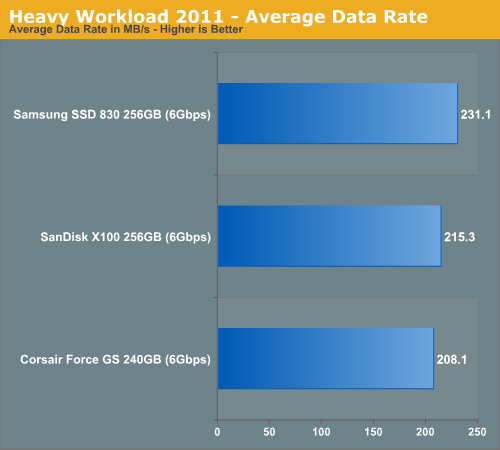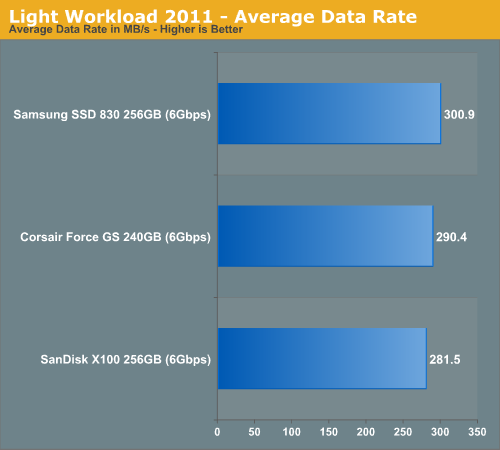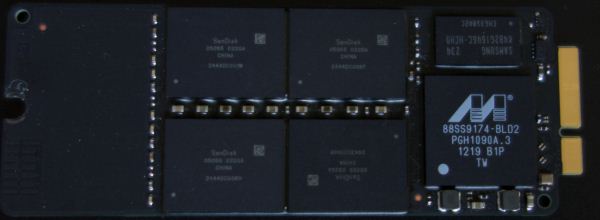Apple Is Now Using SanDisk SSDs in the Retina MacBook Pro As Well
by Kristian Vättö on February 5, 2013 11:48 AM EST- Posted in
- Storage
- Mac
- SSDs
- Marvell
- MacBook Pro
- MacBook Air
- SanDisk
- Retina
There has always been some level of lottery involved when buying an SSD-equipped Mac. The first Mac to start the lottery was the 2010 MacBook Air, which initially used Toshiba's SSDs but later it was found that some units were shipping Samsung SSD 470 based drives. Up until last year Apple kept using the same Toshiba and Samsung SSDs; the 2012 refresh finally brought SATA 6Gbps SSDs to Macs and, of course, another round of lottery too. The 2012 MacBook Air kept using drives from both Toshiba and Samsung, albeit both were newer generation (Toshiba's is SF-2281 based, Samsung is PM830). The rMBP, however, used only SSDs from Samsung, and the 256GB and 512GB SSDs in the MacBook Air were all Samsung made as well.
Late last year it was discovered that some rMBPs might be using SSDs from SanDisk. At that time we only had system profiler screenshots and user reports to go with, which I didn't think was enough to go by (after all, the controller is the most interesting part of the story anyway). Today, I have some pictures to show:
Courtesy of MacRumors forum user Artagra
In short, that's a custom version of SanDisk's X100 mSATA SSD. The controller is Marvell's 88SS9174, which is also used in Crucial m4, Intel SSD 510, and Plextor M5S, each with custom firmware. That's coupled by eight (four on each side of the PCB) 24nm Toggle-Mode MLC NAND packages from SanDisk (SanDisk has a NAND joint-operation with Toshiba). Anand actually has an X100 in the house and just finished running tests on it a few days ago, so here's a brief comparison of the SSDs used in Macs at the moment (Corsair Force GS is the closest match to the Toshiba SSD):


Note that these are all retail drives; the drives Apple is using are custom and hence the performance may be slightly different (customized firmware). The X100 in the graphs is actually a newer 88SS9175 based X100 (it might be X110 as SanDisk wasn't very specific) so performance of the 9174 based might be slightly different (we shouldn't be anywhere close to U100 speeds, fortunately). The 9175 is essentially just a low-power version of the 9174 with only four channels, so I wouldn't be surprised if the 9174 based X100 was even faster. However, all the drives Apple uses are good performers. The SSD 830 is the fastest of them all but the X100 and Toshiba are trading blows as you can see above.
I'm not surprised by Apple's move. Apple is constantly buying more and more SSDs (and flash in general) and relying on just one supplier is risky. If one manufacturer has a hiccup in production, Apple still has the channel to quickly buy SSDs from another manufacturer. There's also a possibility that the availability of Samsung PM830 is decreasing because it's now a discontinued product. Samsung told me they still have plenty of stock for OEM and B2B customers but the volume Apple needs is fairly significant and Samsung may not be able to supply that anymore. Samsung does have a newer SSD 840 (Pro) available but it's possible that Samsung's pricing made Apple choose SanDisk.
Either way, SanDisk is now the third OEM to supply SSDs to Apple. I've only seen the X100 appear in the rMBPs so far but it's certainly possible that we will see SanDisk SSDs in other Macs (such as the Air) too. While I'm sure most of the buyers would prefer the Samsung SSD (including myself), the good news is that none of the drives Apple is using are exceptionally bad. Unless your workload is very IO intensive, there shouldn't be a significant difference in real world performance (except when dealing with incompressible data and the Toshiba drive).
Thanks Paul for giving us the permission to use your picture!












31 Comments
View All Comments
maratus - Tuesday, February 5, 2013 - link
What a foolish stereotype.I have a 15" rMBP (2.3Ghz/16Gb/768gb) as my primary laptop as there's absolutely no rivals at the moment. It's simply the most impressive laptop I've ever seen.
For the desktop, my choice is a small workstation (p9x79 pro + 3930k, GTX 670/680 and matched 64Gb ddr3-1600 kit from g.skill) and other minor things, all in small Lian-Li case with custom watercooling setup. And yes, I do care about what in my MacBook Pro as well.
I don't like their upgrade price, but the base price of Apple retina laptops is justified by top-class screen, performance (esp graphics in 15"), weight and battery life combination.
Flunk - Tuesday, February 5, 2013 - link
You do have to admit the performance isn't exactly top tier. You have to give up a lot to get to that low a weight and thickness.Greg512 - Tuesday, February 5, 2013 - link
You can certainly get much more powerful computers for the money, but none under five pounds, at least with decent battery life. Even under six pounds it is a stretch. That being said, it is still a very powerful laptop, but nothing spectacular.p_giguere1 - Tuesday, February 5, 2013 - link
You mean gaming performance?Not being a gamer and caring about having the most powerful GPU around doesn't mean you don't care about storage speed, which is useful even for non-gamers.
The rMBP isn't targeting gamers, unlike most laptops of this price range. You sacrifice GPU performance for a thinner and lighter laptop with a better battery life and better display. Good tradeoff if you don't game.
nerd1 - Wednesday, February 6, 2013 - link
1080p IPS displays are pretty much standard nowadays, as well as 6+ hrs battery life (thanks to ivy bridge processors and switchable GPU)And 'retina' resolution is plain overkill - you are not allowed to use the full native resolution in OSX anyway .
p_giguere1 - Wednesday, February 6, 2013 - link
Whether the resolution is overkill for you depends on your usage and how much you value screen quality, much like someone might not need/value a powerful gaming GPU and call it overkill. Different stroke for different folks.You certainly are allowed to use the full resolution in OS X, it uses it by default out of the box. You must be talking about disabling HiDPI mode in order to get the maximum screen estate, which requires 3rd party software but isn't prohibited by Apple in any way. Having tried it myself, I doubt it's something you'd really want to do though.
KoolAidMan1 - Wednesday, February 6, 2013 - link
Overkill how? Look at how text renders or fire up Aperture/Photoshop Lightroom and then tell me that the display is overkill.maratus - Wednesday, February 6, 2013 - link
The situation is getting better, but I disagree with few statements.1. You're free to choose between different modes, and I occasionally even use native 2880x1800 (I use QuickRes).
2. There're still not many laptops with full-hd 1080p screen.
3. Not all of them have a top mid-class GPU.
4. Now pick up those that actually have a similar 85-95Wh battery by default
5. If you don't value low thickness, how about 2kg threshold for a 15" screen models?
6. Now how many still have 16:10 ratio?
7. And how about running two 2560x1600 30" dislpays with an option of 3rd (1920x1200) AND internal screen at the same time? P.S. Not in mirror mode.
8. Last, but not least: How about a native PCI-E bus for external peripherals like GPUs or audio controllers?
JPForums - Thursday, February 7, 2013 - link
1) As I understand it, you need a third party tool to disable HiDPI mode. Though personally, I don't consider that a problem.2) There are plenty. Look around. The problem is finding IPS displays. Then try to find one with a reasonable color gamut and accuracy. If you need a wide color gamut, your options really dwindle.
3) I could just as easily point out the number of Macbooks with high end GPUs. The tradeoff really depends on your priority.
4) Good point. Most comparable notebooks I've seen like to stuff a higher end CPU/GPU which requires more space and weight for the cooling solution. They tend to use smaller batteries to compensate. As a further concession, MAC OS has been shown to get better battery life than Windows 7 (Tested on MacBook). I'm not really sure about Windows 8.
5) Neither thickness nor weight is a problem for me. I'd rather have a larger battery.
6) This is my biggest issue with notebooks. I consider 16x10 resolutions superior to 16:9. Especially when the big push behind moving to 16:9 (movies) was negated when studios decided to use even wider aspect ratios.
7) This can be done with several laptops I've seen. Pretty much any ATi based laptop with the required connectors I've worked with can do it. (I think nVidia is limited to 3) Don't confuse this for an Apple advantage.
8) How is carrying around all those extra peripherals working out for you? You play the weight advantage, the size advantage, and the battery life advantage, but all of those go out the window if you have to carry extra items with you. I can always carry extra batteries to make up for lack of battery life with a normal notebook, but that limits portability. So the usefulness of the external PCIe is limited to when it is docked. I prefer a laptop that already has what I need. For a docked system I'll stick with a much more powerful desktop.
Truth be told, I'd love to get a MacBook Pro if only for the 16:10 aspect ratio. Top it off with the gorgeous color reproduction and I almost want to throw my current notebook out the window. However, the tradeoffs they make aren't really to my liking at the moment. I'd rather have something with a little more graphics muscle (games are only part of the reason) and sacrifice thickness and weight. Alternately, give me 12 - 15 hrs of real, productive use (I need either Windows or Linux ATM) and I'll forgo the high end graphics. Again, thickness and weight aren't an issue for me, though for this one I'd prefer something that isn't Dell XPS (original) thick. For now, I'll just use my desktop with a larger, even more gorgeous, fully calibrated, 16:10 display for serious work. My current laptop will suffice for light work.
maratus - Saturday, February 9, 2013 - link
1) yep2) Sorry, I meant fullHD and IPS
3) True, though I've never been interested in them. 13 rMbP is nice due to the screen and battery life, but everything (cMBP, Air) else isn't quite up to this line.
5) So photo-oriented backpacks, for instance, greatly benefit from reduced thickness. Less stress on the internal compartment and easy to operate
7) I didn't know that laptop Displayports actually work fine for daisy chaining. I usually deal with nice laptops (top Sony lines) with HDMI only onboard :)
My main point is that rMBP is compatible with 3 monitors regardless of the connection type, I'm not sure you can run several DVI from a single Displayport. rMBP has three separate ports to connect to, that somewhat unique. You can arrive in your partners office and quickly setup multi-monitor setup out of what they have
8) that for stationary use only, of course. I personally don't use it as the PCi-e extensions are very expensive.